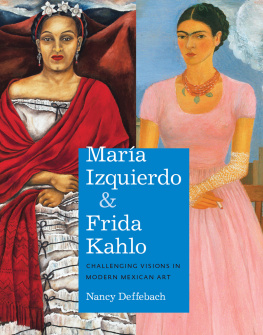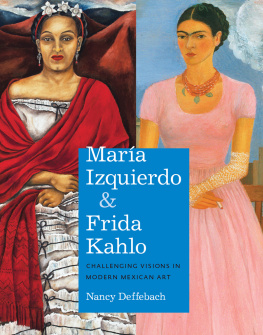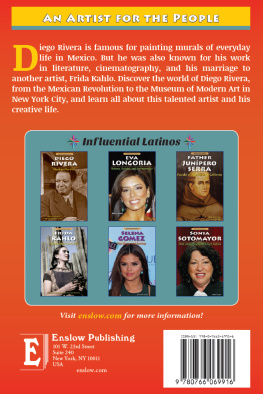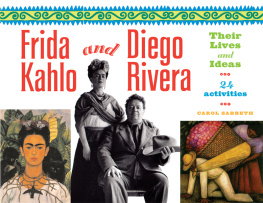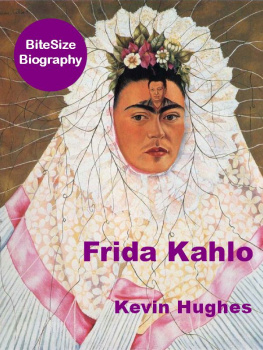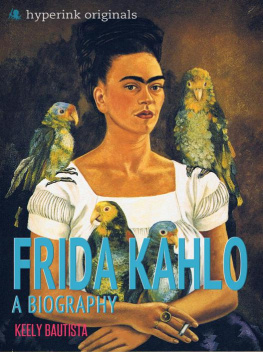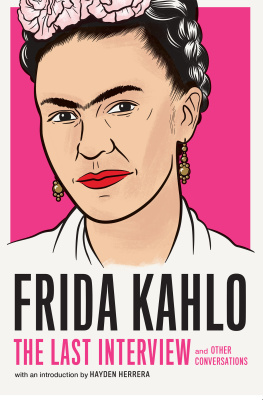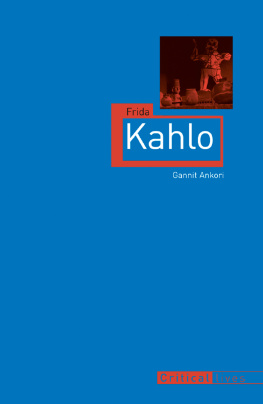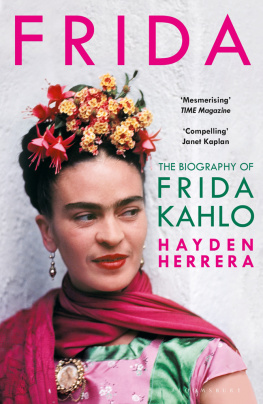Mara Izquierdo & Frida Kahlo
CHALLENGING VISIONS IN MODERN MEXICAN ART
Nancy Deffebach
UNIVERSITY OF TEXAS PRESS
AUSTIN
To my friends
Kim Grant, Daniel Nelson, Susan Webster,
Florencia Bazzano, and Ana Garduo
This book is a part of the Latin American and Caribbean Arts and Culture publication initiative, funded by a grant from the Andrew W. Mellon Foundation.

Copyright 2015 by the University of Texas Press
All rights reserved
First edition, 2015
Requests for permission to reproduce material from this work should be sent to:
Permissions
University of Texas Press
P.O. Box 7819
Austin, TX 787137819
http://utpress.utexas.edu/index.php/rp-form
Library of Congress Cataloging-in-Publication Data
Deffebach, Nancy, author.
Mara Izquierdo and Frida Kahlo : challenging visions in modern Mexican art / Nancy Deffebach. First edition.
pages cm (Latin American and Caribbean Arts and Culture publication initiative
Andrew W. Mellon Foundation))
Includes bibliographical references and index.
ISBN 978-0-292-77242-7 (cloth : alk. paper) ISBN 978-1-4773-0049-7 (library e-book) ISBN 978-1-4773-0050-3 (non-library e-book)
1. Izquierdo, Mara, 19021955Criticism and interpretation. 2. Kahlo, FridaCriticism and interpretation. 3. Women artistsMexico. 4. Feminism and art. I. Title.
ND259.I97D46 2015
759.972dc23 2014046327
doi:10.7560/772427
ACKNOWLEDGMENTS
Many people helped me create this book. I especially wish to thank Mara Izquierdos younger daughter, Aurora Posadas Izquierdo, and granddaughter, Mara Rosenda Lpez Posadas. I first interviewed Aurora Posadas Izquierdo in 1995 and continued to interview and consult her for many years. I also want to thank Amparo Posadas de Carmona, Izquierdos older daughter, whom I interviewed once in 2003 and who accompanied me on a daytrip to her mothers hometown, San Juan de los Lagos, the following day. These and other interviews have contributed enormously to my understanding of the art of Mara Izquierdo, Frida Kahlo, and modern Mexico. Some of my interviews preceded my graduate studies, some were conducted while I was researching my dissertation, and others were conducted specifically for this book. For interviews cited in this text, I thank Leonora Carrington, Jaime Cuadriello, Arturo Estrada, Fernando Gamboa, Arturo Garca Bustos, Alejandro Gmez Arias, Isolda Kahlo, Guillermo Monroy, Juan OGorman, Dolores Olmedo, Guadalupe Rivera Marn, Fernando Serrano Migalln, Rafael Vzquez, Hctor Xavier, Mariana Yampolsky, Alfredo Zalce, and Adelina Zendejas. In addition to the interviews that I cite here, I conducted many others that have also informed my understanding of Mexican art.
I am profoundly indebted to my friends Kim Grant, Daniel Nelson, and Susan Webster for reading drafts of chapters of the manuscript, giving me advice about writing, and making countless suggestions about how to express my ideas effectively. I am equally grateful to Ana Garduo for reading and commenting on the contents of the introduction and an early version of . She also helped me in countless ways with research in Mexico. I thank Florencia Bazzano for many conversations about Latin American art. I dedicate the book to these friends.
Rosamara Graziani translated to Spanish earlier versions of two chapters that were published in Latin America. She also helped with extensive correspondence in Spanish and other forms of research over many years. Unless otherwise noted, translations from Spanish to English in this book are mine, but corrected and revised by Rosamara Graziani and other native speakers.
I have received help in various formsletters, emails, permissions, information, insight, and other assistancefrom the following people: Guadalupe Alonso Alanis, Tere Arcq, Marisol Argelles, Virginia Armella de Aspe, Jacqueline Barnitz, Florencia Bazzano, Jo-Anne Berelowitz, Janice Bergman-Carton, Sheelagh Bevan, Andrs Blaisten, Laurel Bliss, Lucienne Bloch, Walther Boelsterly, Diana Briuolo, George Butler, Mario Campoamor, Deborah Caplow, Craig Carlson, Michael Coelho, Karen Cordero, Leigh Cotnoir, Charles Cramer, Jaime Cuadrillo, Rafael Doniz, Eduardo Douglas, Mara Estela Duarte Snchez, James Farmer, Barbara Fredrich, Amy Galpin, Ana Garduo, Marta Garsd, Jennifer Giancarlo, Catherine Gleason, Danielle Goebel, Pablo Goebel, Pablo Gmez Ascencio, Mara de Jesus Gonzlez, Martn Gonzlez Figueroa, Kim Grant, Rosamara Graziani, James W. Grebl, Cheryl Hartup, Linda Henderson, Gloria Hernndez, Doris Heyden, Gerardo Hierro Molina, Javier Hinojosa, Daniela Kelly, Francisco Kochen, Peter Krieger, Ray Legans, Amna Malik, Carlos Martell, Mary-Anne Martin, Miguel ngel Martnez Alfaro, Cuauhtmoc Medina, Pablo Mndez, Eliseo Mijangos, Paulina Milln Vargas, Debra Nagao, Hernn Navarrete, Daniel Nelson, Gabriela Nez, James Oles, Blair Paltridge, Catha Paquette, Ramona Prez, Santiago Prez, Mariana Prez Amor, Juan Antonio Prez Simn, Cecilia Puerto, Alice Rahon, Fausto Ramrez, Lzaro Ramrez Victoria, Julio Revolledo Crdenas, Alejandra Reygadas de Yturbe, Anitza Rodrguez, David Rohr, Judy Rohr, Claudia Salas Rodrguez, Osvaldo Snchez, Linda Schele, Michael Schreffler, Pio Schurti, Vanina Scocchera, Erica Segres, Daniel J. Sherman, Jaime Soler, Juan Soriano, Elisa Tllez, Graciela Tllez Trevilla, Beatriz de la Torre, Hilda Trujillo, Beatriz Uras Horcasitas, Susan Vondrak, Jannelle Weakly, Barbara D. Webster, Grady L. Webster, Susan Verdi Webster, Marsha Weidner, and Allyson Williams.
At the University of Texas Press, I am enormously grateful to my editors, Theresa May, Kerry Webb, and Kathy Burford Lewis. Theresa May enthusiastically supported and encouraged this project from the initial proposal through the delivery of the final manuscript. Kerry Webb guided the project to completion, and Kathy Burford Lewis contributed careful copyediting; Maia Wright designed the book. The book also benefited from the help and expertise of John McLeod, Kaila Wyllys, Nancy Lavender Bryan, and Angelica Lopez. The two external reviewers provided astute suggestions for revising the text. Through the University of Texas Press, the book received a Latin American and Caribbean Arts and Culture grant from the Andrew W. Mellon Foundation.
I am grateful as well to Dr. Xavier Guzmn Urbiola, head of the Subdireccin General del Patrimonio Artstico Inmueble, for allowing me to reproduce works by Frida Kahlo, Mara Izquierdo, Diego Rivera, Jos Clemente Orozco, and David Alfaro Siqueiros.
My research benefited from a Mellon Postdoctoral Fellowship at Rice University, a research grant from San Diego State University, a semester of sabbatical from San Diego State University in fall 2012, and travel funds from the San Diego State University Art Council.
For their affection, support, humor, and good company, I express my love and appreciation to my sister, brother-in-law, niece, nephew, and extended family on the central coast of California: Judy and David Rohr; Kacey, Brian, and Jase Burns; Danny, Tricia, Paxton, and Riley Rohr; Ray Legans and Rick Tulloss; and Fred Hindler.
I photographed the following images: figures .
Introduction
You do not paint with your hands: the painting should be born in your soul, pass through your brain, and then your emotions must spill it onto a canvas, panel, or wall.
MARA IZQUIERDO, MI PINTURA, 1950
The most important part of the body is the brain.
FRIDA KAHLO, IN AN INTERVIEW WITH OLGA CAMPOS, 1950
During the height of the Mexican muralist movement, Mara Izquierdo (19021955) and Frida Kahlo (19071954) established successful careers as easel painters and created bodies of work that have become integral to Mexican modernism ( The two women artists made small and mediumsized easel paintings. Most of their works represent women, and some address personal themes, even though the muralists advocated a radically different type of art.
Next page
